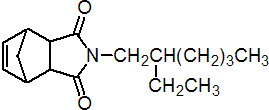|
ENT 8184
Insecticide synergist

NOMENCLATURE
IUPAC name N-(2-ethylhexyl)-8,9,10-trinorborn-5-ene-2,3-dicarboximide; N-(2-ethylhexyl)bicyclo[2.2.1]hept-5-ene-2,3-dicarboximide
Chemical Abstracts name 2-(2-ethylhexyl)-3a,4,7,7a-tetrahydro-4,7-methano-1H-isoindole-1,3(2H)-dione
Other names N-octylbicycloheptenedicarboximide CAS RN [113-48-4] Development codes MGK 264 (MGK) Official codes ENT 8184
PHYSICAL CHEMISTRY
Composition The active ingredient is a 55:45 mixture of cis- and trans- isomers, both of which are biologically active. Tech. grade is 98% pure; main impurity 2-ethylhexanol. Mol. wt. 275.4 M.f. C17H25NO2 Form Liquid. M.p. <-20 ºC B.p. 150 ºC/2 mmHg V.p. 2.4 mPa (25 ºC) KOW logP = 3.61 (cis- isomer); 3.80 (trans- isomer) S.g./density 1.046 (20 ºC) Solubility Practically insoluble in water. Miscible with most organic solvents including petroleum oils, fluorinated hydrocarbons, also DDT and HCH. Stability Stable to light and heat. No hydrolysis after 30 d at pH 5-9.
COMMERCIALISATION
History Activity as synergist reported by R. H. Nelson et al. (Soap Chem. Spec., 1949, 25(1), 120). Introduced by Van Dyke Co. and later by McLaughlin Gormley King Co. Patents US 2476512 to McLaughlin Gormley King
APPLICATIONS
Uses A synergist for pyrethroids in aerosol sprays for household and veterinary use. Formulation types Aerosol concentrates; DP.
OTHER PRODUCTS
Discontinued products: 'Octacide 264' * (MGK)
ANALYSIS
Product analysis by glc (CIPAC Handbook, 1985, 1C, 2166; AOAC Methods, 17th Ed., 997.07, 980.04*). Residues determined by glc. In drinking water, by glc with NPD (AOAC Methods, 17th Ed., 991.07). Details available from McLaughlin Gormley King.
MAMMALIAN TOXICOLOGY
Reviews FAO/WHO 8, 9 (see part 2 of the Bibliography). Oral Acute oral LD50 for male rats 4990, female rats 4220 mg/kg. Skin and eye Acute percutaneous LD50 for rabbits 470 mg/kg. Inhalation LC50 (4 h) for rats >4.08 mg/l. NOEL for rats 50 mg/kg daily. NOEL for oncogenicity 450 mg/kg daily. ADI (JMPR) No ADI [1967]. Toxicity class WHO (a.i.) III
ECOTOXICOLOGY
Birds LC50 (8 d) for mallard ducks and bobwhite quail >5620 mg/kg diet. Fish LC50 (96 h) for rainbow trout 1.4, bluegill sunfish 2.4 mg/l. Daphnia LC50 (48 h) 2.3 mg/l.
|